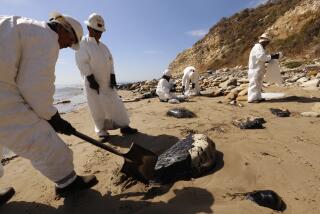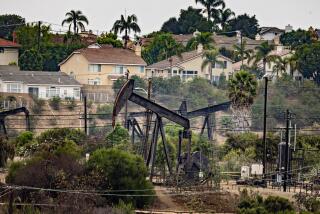Black Gold : A occasional look at Orange County issues
- Share via
Far from being an artifact of a bygone era, the oil industry is still active in Orange County. Last year, the county produced more than 6.7 million barrels, about one-sixth its peak output, in 1956. A look at whence the oil comes and how:
Production Decline
Orange County oil production peaked in 1956, with a yield of nearly 42 million barrels. Since then it has dwindled, more or less steadily. A look at oil produced over the years, in millions of barrels:
1956: 41.7
1995: 6.7
Field File
Where hundreds of oil fields once flourished in Orange County, now only nine are active onshore and three offshore. Production and reserve numbers in barrels of oil:
1. Belmont Offshore
Major operator: Exxon
Discovered: 1947
1995 production: 174,000
Five-year production: 1.0 million
Reserves: 7.0 million
2. Brea Olinda
Major operator: Cal Resources LLC, Union Oil Co. and Brea Canon Oil Co.
Discovered: 1897
1995 production: 1.4 million
Five-year production: 7.8 million
Reserves: 43.0 million
3. East Coyote
Major operator: Union Oil Co.
Discovered: 1909
1995 production: 276,899
Five-year production: 2.2 million
Reserves: 9.9 million
4. Esperanza
Major operator: Columbine Associates and Hillcrest Beverly
Discovered: 1956
1995 production: 11,587
Five-year production: 62,850
Reserves: 104,000
5. Huntington Beach Onshore
Major operator: Huntington Beach Co.
Discovered: 1920
1995 production: 1.11 million
Five-year production: 5.7 million
Reserves: 20.0 million
6. Huntington Beach Offshore
Major operator: Cal Resources LLC
Discovered: 1933
1995 production: 2.0 million
Five-year production: 12.3 million
Reserves: 25.7 million
7. West Newport Onshore
Major operator: West Newport Oil Co.
Discovered: 1943
1995 production: 183,104
Five-year production: 1.6 million
Reserves: 3.3 million
8. West Newport Offshore
Major operator: City of Newport Beach
Discovered: 1953
1995 production: 47,770
Five-year production: 245,740
Reserves: 619,000
9. Olive
Major operator: Bridgemark Corp.
Discovered: 1953
1995 production: 32,949
Five-year production: 165,349
Reserves: 480,000
10. Richfield
Major operator: Union Oil Co. and SABA Petroleum
Discovered: 1957
1995 production: 731,796
Five-year production: 4.2 million
Reserves: 6.4 million
11. Seal Beach
Major operator: McFarland Energy Co. and Termino Co.
Discovered: 1924
1995 production: 203,661
Five-year production: 1.2 million
Reserves: 8.6 million
12. Yorba Linda
Major operator: Cal Resources LLC
Discovered: 1954
1995 production: 569,873
Five-year production: 3.6 million
Reserves: 16.1 million
Active and Idle
About 40% of Orange County’s nearly 3,000 oil wells are not producing. Approximately 100 wells per year are plugged and abandoned. A look at the productive and idle wells:
Field
1. Belmont Offshore:
Producing: 14
Idle: 45
2. Brea Olinda:
Producing: 607
Idle: 325
3. East Coyote:
Producing: 81
Idle: 35
4. Esperanza:
Producing: 12
Idle: 0
5. Huntington Beach Onshore:
Producing: 265
Idle: 91
6. Huntington Beach Offshore:
Producing: 138
Idle: 306
7. West Newport Onshore:
Producing: 94
Idle: 100
8. West Newport Offshore:
Producing: 16
Idle: 0
9. Olive:
Producing: 4
Idle: 3
10. Richfield:
Producing: 175
Idle: 46
11. Seal Beach:
Producing: 70
Idle: 15
12. Yorba Linda:
Producing: 235
Idle: 241
Total:
Producing: 1,711
Idle: 1,207
Drawn From the Depths
Lowered 200 to 300 feet into a well’s fluid, submersible pumps are powered from the surface. They lift fluids to the wellhead using a multiple-stage pump. Here’s how:
1. Well fluids (oil, water and some gases) enter pump at pump intake.
2. Fluids flow through multistage pump and reach the surface through 2 3/8 - 3 1/2” tubing.
3. Master valve, which controls fluid flow, sits in concrete cellar; cellar wall contains spillage.
4. Fluid moves through flow line pipe to storage tank.
Down in the Hole
Electric cable, supplying power, weighs two pounds per foot and is protected by a steel jacket.
Pump uses stages stacked atop each other to lift a given amount of fluid a given amount of feet. Both amount and distance vary by design.
Pump intake is a series of holes through which fluids flow to first pump stage.
Seal section protects the electric motor and connects motor drive shaft to the pump.
Electric motor provides power for the pump, turning at about 3,500 rpms and operating from 230 volts to 5,000 volts.
Connected by Rod
Probably the most visible aspect of the oil industry in Orange County is walking beam units that resemble industrial insects. Walking-beam units operate rod pumps, which are cheaper to run than a submersible pump and require less maintenance. However, they need more room and are an aesthetic concern.
1. Polished rod of high-carbon steel passes through stuffing box, where it is lubricated.
2. Pumping tee in stuffing box directs fluid flow to storage.
3. Sucker rod, 1/2 -1 1/4” diameter carbon/manganese steel, connects polished rod to pump plunger.
Up the Tube
The business end of the rod-pump system is a barrel and plunger and pair of valves working together to allow fluid to be lifted to the surface in stages. How it works:
1. Down Stroke
Sucker rod pushes down on pump barrel.
Vents allow fluid to escape into tubing.
Pump barrel empties from top while fluid enters through bottom.
Traveling valve opens, allowing fluid to enter barrel.
Standing valve closes, creating seal.
2. Upstroke
Sucker rod lifts barrel.
Pump barrel, full, forces fluid above it to surface.
Traveling valve closes, keeping fluid inside pump barrel.
Standing valve, opened by suction of pump barrel motion, opens and allows fluid to enter pump barrel.
Chronology of Crude
Some highlights in Orange County’s oil history:
1876: Los Angeles Gas Co. begins scooping up northern Orange County asphalt for use in the manufacture of gas for heating and lighting.
1882: Presence of crude oil in Brea is known, but equipment is too primitive to drill wellsthat would yield profitable quantities.
1884: Oil lease houses for oil workers and their families begin cropping up after first big oil strike at the Puente field northwest of Brea.
1890: Union Oil Co. forms in Orange County; makes first major oil discoveries near Brea; begins producing half a million barrels of crude oil a year.
1919: Union Oil Co. discovers oil 3,000 feet beneath Placentia.
1920: Standard Oil Co. strikes oil in Huntington Beach; first well yields 45 barrels per day.
1925: Orange County’s petroleum sales peak at $48 million.
1930: County petroleum sales slip to $26 million as some fields begin to dry up and prices fall because of the Depression.
1940: County oil sales drop to $18 million.
1956: County oil production peaks at 41.7 million barrels.
1983: Nearly 19 million barrels of oil valued at $418 million came from county wells.
1990: To shake its oil town image, Huntington Beach City Council adopts new oil and gas production code, requiring companies to eliminate wells producing less than 90 barrels every three months. Code is later declared illegal and repealed by the city.
1993: Orange County has 2,020 oil-producing wells--1,815 onshore and 205 offshore. Of the 1,145 idle wells, 71% were onshore and 29% were offshore.
1994: Huntington Beach has the highest producing oil fields with 3.9 million barrels.
1995: West Coyote field in Brea is abandoned for housing development.
Notes From the Underground
There are more than 140 million barrels of known oil reserves beneath Orange County.
Orange County’s three “giant fields”--Huntington Beach, Brea Olinda and Yorba Linda--will eventually produce more than 100 million barrels of oil.
A barrel of oil contains 42 gallons.
In 1972, an Orange County oil well was worth about $1,000 for each barrel of oil it pumped daily.
Prehistoric people used a black gooey byproduct of crude oil to waterproof baskets; early Spaniards used the substance to seal roofs.
Brea got its name from the Spanish word for the black gooey substance.
Carbon Canyon Regional Park is on the site of the now extinct Olinda oil community.
In the 1930s and 1940s, oil wells were operated by noisy one-cylinder gasoline engines called “hit and miss” engines because they fired irregularly. People living in oil lease houses said it sounded like a 12-gauge shotgun going off.
In the 1940s, the Federal Housing Administration would not loan money on a house within sight of an oil well. Today, there are houses and apartments next door to pumpers and houses built over abandon wells.
* Sources: California Department of Conservation--Division of Oil and Gas, World Book Encyclopedia, Times reports; Researched by MIKE SPENCER, CAROLINE LEMKE and DAVID PUCKETT / Los Angeles Times
More to Read
Sign up for Essential California
The most important California stories and recommendations in your inbox every morning.
You may occasionally receive promotional content from the Los Angeles Times.










